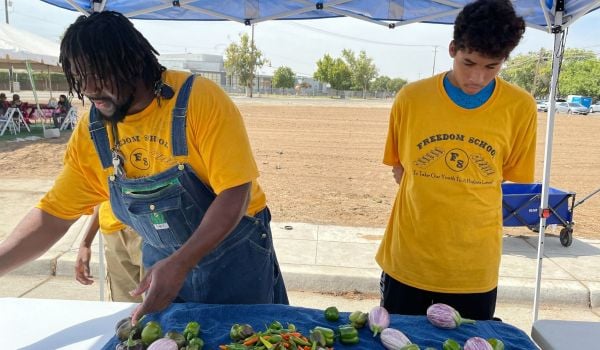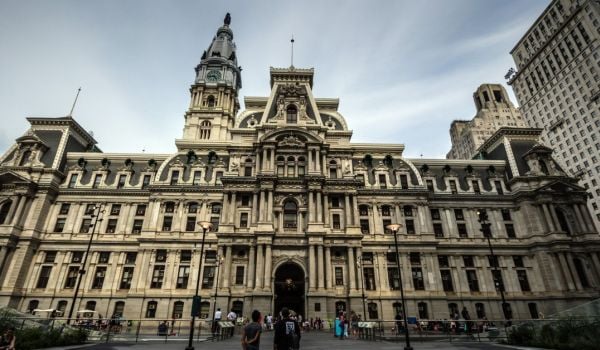Three years ago, the federal government created Opportunity Zones as a way to encourage private investors to bring an influx of money to struggling urban and rural neighborhoods through tax incentives. The promise of Opportunity Zones to communities? Add affordable housing, boost small businesses owned by Black entrepreneurs and other people of color, and bring solid jobs to local residents, many of whom are living below the poverty level.
But last year, when Angeline Johnson arrived in Wichita, Kansas, as a FUSE executive fellow tasked by the City Manager’s Office with encouraging equitable investment in Opportunity Zones (OZs), she discovered that some residents in northeast Wichita had mobilized to share concerns about their OZ designation.
“There was a legitimate fear of gentrification and displacement,” Johnson said.
The value of OZs to underserved communities has come under scrutiny. Attempting to track the program’s community impact, the Urban Institute released an early assessment recently that identified several issues. The most glaring, said Jorge González, a research analyst in the Metropolitan Housing and Communities Policy Center at the Urban Institute, is that the federal government offers no guidelines on which projects receive the incentive, apart from the exclusion of a few “sin” businesses (such as liquor stores and facilities used for gambling), while limited oversight and little transparency hinder efforts to track impact.
In Wichita, Johnson saw firsthand how loose guidelines and little transparency around OZs could not only exclude the community it was meant to serve, but also create fear and distrust among residents.
City and county agencies, however, don’t need approval from the federal government to find ways to be more inclusive. Johnson was one of four FUSE executive fellows who worked with local governments to ensure that the voices of marginalized communities are heard and community benefits are part of the OZ equation. In addition to those insights, here’s what they learned about keeping OZs in the best interest of the communities they’re meant to serve.
Work alongside neighborhood activists and community members.
For Johnson, the organized opposition in Wichita was an effective way to hone in on a specific community, who she then engaged with through small group meetings and one-on-one discussions. New to the community, Johnson emphasized her role as someone designated by the city to prioritize equitable development.
“There were already issues with the city,” she said. “Not being an employee of the city, however, but someone contracted to support an agenda that matched the community’s, I pushed that to build relationships and trust.”
Johnson also positioned herself as a liaison to city officials who could help amplify the community’s needs. “I was able to offer some degree of influence or access that ordinarily wouldn’t be there,” she said.
Stacy Cumberbatch was brought in as a FUSE fellow to help identify community needs in Riverside County, California, and create a county prospectus document, working in partnership with the Economic Development Agencies in 14 cities with OZ census tracts. She found, too, that certain groups had mobilized across the county to identify their needs, wanting to set priorities for future economic development. By meeting with those community organizations, she learned that there’s a strong need for living-wage jobs, economic mobility, and accessible housing for all populations.
Cumberbatch also reached out to institutions already doing similar work, such as banks working with underserved small business owners, and she connected with leaders of Native American tribes and groups like the local African American Chamber, Small Business Majority, USA Vets, Habitat for Humanity, and the county’s grantmaking organization, meeting with them one-on-one or sharing resources. She asked the grantmaking organization what nonprofits are applying for and what aid is needed for lower-income communities. With each organization, she outlined how OZ investments or aligned grants could potentially benefit the organization’s development pipeline.
“To build trust,” she said, “we were including people in instances where they may not have been expected to be included.” This meant asking about priorities and development goals around seeking investments, for example, to help them benefit from OZ investors interested in the region. In other cases, it meant connecting an OZ project seeking investment with a relevant community organization. She found Qualified Opportunity Zone Businesses expanding into the area particularly interested in connecting with the community and usually initiating the request themselves.
To help the city of Coachella’s Economic Development Agency launch its OZ efforts, Cumberbatch is developing a competition in partnership with the Mastercard City Possible team to attract businesses and inspire community input. It will award cash prizes to three businesses identified as high priority by the city that are willing to launch or relocate to Coachella, and $5,000 in cash prizes will also be awarded to community members who respond to an OZ-focused questionnaire created by the city.
“We’ll be encouraging business growth in our OZs and incentivizing community members to participate in their own economic development, asking what types of businesses they want to see in the Opportunity Zone,” she said. “Further down on the page, we educate people on what Opportunity Zones are in simple layman’s terms.” The goal next year, after the competition launches, is to compile data from the questionnaire to better match city and community priorities.
Clearly state the needs of the community.
To help northeast Wichita community members become key stakeholders in OZ development, Johnson worked in close collaboration with the group to develop a community benefits agreement. These contracts, signed by community groups and real estate developers, typically require the developer to provide specific amenities or mitigations to neighborhoods.
“Community benefits agreements typically come out of a pushback to development, and it’s usually contentious,” she explained. But Johnson shared the community’s concerns with Wichita’s city manager, who agreed that a community benefits agreement could effectively establish a partnership between the city and communities.
So far, the group has engaged more than 150 community members and generated a report that highlights 16 key findings in regards to community needs, including food accessibility, employment and job training, financial literacy, and support for the reentry population. The report will inform the community benefits agreement, which is still under development.
Educate cross-sector stakeholders to get everyone on the same page.
OZ development involves government officials, the communities, private developers and investors, and the banks, CPAs, and attorneys implementing deals. With so many stakeholders, it’s essential to make sure everyone understands what OZs are as well as the intended impact of equitable community development.
Part of Cumberbatch’s strategy, in collaboration with the county EDA, included organizing education-focused events, which were attended by more than 300 participants. “Community members would sit with us for two or three hours with experts that we brought in to learn about Opportunity Zones and how they can work with local officials and investors to bring projects forward,” she said.
These events proved pivotal in clearing up confusion. “A question might come in that’s off base,” she said. “Some people still had the impression this was a program to plug into, and not an investment opportunity to seek.”
As a FUSE fellow, Gil Keinan worked with 15 cities on OZ development for the San Bernardino County Economic Development Agency. In addition to local engagement through listening tours, Keinan also brought county and city staff, developers and investors, local universities, nonprofits, and other stakeholders into the same room for an overview of the incentive and its potential for each specific community. “Within San Bernardino County there are 57 certified Opportunity Zones, the second most in the state behind Los Angeles County,” he said. “Because we are so diversified, there really is no one size fits all, and we needed to make sure that we took a different approach in each community.”
For OZs in a downtown district, for example, he stressed the potential for investment in local businesses over residential development. “That positioned the conversation to remind people of local deals and various assets and developers that need support,” he said.
Keinan helped land an OZ project to develop a medical office building in San Bernardino that will house the county’s Children’s Department of Behavioral Health, which provides services to families in the community. And a need for more diverse and affordable housing led to an OZ deal in Ontario, California, to build affordable housing for residents making 60 percent and below the area median income.
Connect the dots between the investment and the community benefit.
To help communities assess the potential social impact of a project, the Urban Institute developed an Opportunity Zone Community Impact Assessment Tool. Among other intended uses, the tool can help communities determine if a project could be potentially harmful so they can address these concerns with city officials and developers.
González added that several states — Alabama, Virginia, and Louisiana, to name a few — set up databases to align mission-oriented projects and investors. “We’ve found in our research that people trying to do good things with this incentive have a hard time finding investors,” he said. “They really need that extra help.”
In San Bernardino County, Keinan coupled community needs with data. His listening tour revealed a widespread desire for affordable, senior, and workforce housing, so his team used aggregated data to back up that need, such as identifying OZ tracts with the highest growth in the senior population and cities expected to have high growth based on historical trends. This kind of upfront work meant he could point a developer interested in building senior housing to specific areas with the greatest need.
According to González, investors focused on mission-driven projects that don’t produce high returns on investment often struggle to fully fund them. “They need to pull in money from different sources,” he said.
To address that, Cumberbatch spoke regularly with representatives from the California Governor’s Office of Business and Economic Development and the Department of Housing and Urban Development, who were key in helping identify state and federal incentives such as credits, low-cost loans, and grants that could further help fund community development in OZs. To date, there are more than 300 federal grants and programs that would provide either preference points or priority consideration if connected to OZs across the nation.
To further incentivize community development, Cumberbatch identified where OZs overlap with the federal program HUBZones. Small businesses within HUBZones receive priority consideration for procurement for government contracts. “We can say to business owners that if you relocate into an OZ, you may not only benefit from an OZ investor, but you open yourself up to have priority consideration for government contracting,” she noted.
Identifying different funding streams offers more opportunities to push equitable development, Johnson agreed. The Trump administration instructed federal agencies that distribute grants to provide priority status to projects in OZs. “I encouraged the different entities applying to federal funds to speak specifically to how their requested funds would benefit residents in Opportunity Zones,” she said.
Equity and the community need to be part of every conversation with interested investors, stressed Cumberbatch. “A part of the conversation needs to be, this is for the benefit of the community,” she said. “How are you thinking about community benefits or how the needs of the community are served?”
Within the OZ community, she has already seen this focus increase during the past several months, with new projects expected to speak upfront about measurable local community benefits and a number of private tools developed to track and report on the impact of OZ investments.
After Cumberbatch prompted a project sponsor seeking investment to consider community-focused development, the sponsor decided to integrate a community land trust on the property. “That was their idea,” she said. “It wasn’t a very heavy-handed approach — just suggesting that they think of what community benefits would make sense within their project.”
Think outside the OZ box.
By the end of 2019, $75 billion had been raised to be dispersed across 12 percent of census tracts designated as OZs, according to The Council of Economic Advisors. “How much of that private capital is flowing into projects that will really deliver change to the communities that live there?” asked González. “We don’t know, because the IRS is not collecting sufficient data on those investments.”
A bipartisan Opportunity Zone Accountability and Transparency Act was introduced last year, but until more is actually done at the federal level, local leaders will have to think creatively about how to address the tracking problem. Wichita’s community benefits agreement, for example, will include a framework for monitoring impact in partnership with the city, according to Johnson.
FUSE fellow Clair Whitmer was brought into Fresno, California, to help with OZ development and has been brainstorming how to track future impact. She’s applying for a U.S. Economic Development Administration grant with a proposal to create a community benefits reporting framework so that Fresno can quantify how investments within OZs accomplish social, environmental, and economic goals. One tool that she’s evaluating comes from the organization Global Impact LLC, which deploys a measurement system known as Impact Rate of Return.
Reimagine OZs as a tool for broader goals.
Much like other incentives, OZs are merely a tool, noted Whitmer. “It’s been treated like a shiny new object, and everybody is focusing on the tool, rather than the goal,” she said. “The goal should be to focus on equity objectives.”
When the pandemic hit, Whitmer’s work in Fresno shifted to helping deploy $4.6 million in COVID-19 relief to small businesses. Through a CARES Act-backed program called Save Our Small Businesses, several well-resourced businesses like legal firms won funding through a random selection process. With a second round of funding, city officials asked Whitmer to make sure more marginalized, less-resourced businesses received funds. Whitmer realized she could use the OZ census tracks and Community Development Block Grant project area boundaries to target businesses operating in the most distressed neighborhoods of the city.
“From a 60,000 foot view, it worked,” Whitmer said. “At the end of it, money was redirected from the wealthier districts to the poorer districts.”
The northeast Wichita residents working to be heard about OZ development in their community received an unexpected benefit from their efforts. The group was invited to meet with the president of Wichita State University to discuss how the university could better serve its surrounding community. During the meeting, the group shared the results of its focus groups. “The university is using those themes to shape, frame, and help influence what they are doing to be more a part of the community in which they sit,” Johnson said. “At this point, the group is being noted and recognized as a voice for the community.”
This story was produced by FUSE Corps, a national executive fellowship program that partners with local government agencies and produces solutions-driven journalism.

Emily Nonko is a social justice and solutions-oriented reporter based in Brooklyn, New York. She covers a range of topics for Next City, including arts and culture, housing, movement building and transit.
Follow Emily .(JavaScript must be enabled to view this email address)












